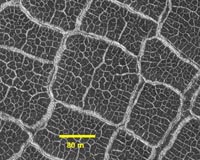 |
Aarhus, Germany (SPX) Sep 17, 2009 Wind speeds and directions were measured for the first time in the Mars polar region using the Phoenix lander's Telltale instrument. Astronomers recorded Easterly winds of approximately 15-20 kilometers per hour during the Martian mid-summer. When autumn approached, the winds increased and switched round to come predominantly from the West. While these winds appeared to be dominated by turbulence, the highest wind speeds recorded of up to nearly 60 kilometers per hour coincided with the passing of weather systems, when also the number of dust devils increased by an order of magnitude. The results were presented this week at the European Planetary Science Congress in Potsdam by Dr. Haraldur Gunnlaugsson. Phoenix landed in the North polar region of Mars on May 25, 2008, and operated successfully for 151 sols (1 sol is a Martian day, which is 37 minute longer than a day on Earth). The Telltale device consisted of a lightweight tube suspended on top of a meteorological mast, roughly two meters above the local surface. The onboard camera continuously imaged the deflection of the tube in the wind, taking more than 7,500 images during the mission. "Telltale has given us a wealth of information about the local Martian wind velocities and directions. At the Phoenix landing site, we were able to see meteorological changes caused by interactions between the dynamic north pole, where there are ever changing evaporation processes, and the Martian atmosphere" said Dr. Gunnlaugsson. Mars is typically a rather windy place and learning more about the planet's climatic conditions will contribute to the understanding of the Martian water cycle and the identification of areas on the red planet that could sustain life. Local wind measurements by the Telltale instrument, amended with daily images of the whole northern hemisphere by the Mars Reconnaissance Orbiter spacecraft, have allowed astronomers to gain much deeper information on weather systems on Mars. "We've seen some unexpected night-time temperature fluctuations and are starting to understand the possible ways dust is put into suspension in the Martian atmosphere. For example, we could see that some of the dust storms on Mars do not require the existence of high winds," said Dr. Gunnlaugsson. Telltale was designed and constructed in Denmark at the Mars Simulation Laboratory at the Aarhus University as a part of the Canadian built meteorological package for Phoenix. "The challenge was to develop an instrument sensitive enough to detect very light breezes and at the same time able to withstand the violent vibrations during the mission launch. The Telltale instrument, although quite simple, has operated very successfully in the thin atmosphere of Mars," said Dr. Gunnlaugsson. Share This Article With Planet Earth
Related Links Telltale Project Physics and Astronomy, Aarhus University Mars News and Information at MarsDaily.com Lunar Dreams and more
 Patterns In Mars Craters Give Picture Of Drying Lakes
Patterns In Mars Craters Give Picture Of Drying LakesPotsdam, Germany (SPX) Sep 16, 2009 Networks of giant polygonal troughs etched across crater basins on Mars have been identified as desiccation cracks caused by evaporating lakes, providing further evidence of a warmer, wetter Martian past. The findings were presented at the European Planetary Science Congress by PhD student Mr. M. Ramy El Maarry of the Max Planck Institute for Solar System Research. The polygons are formed ... read more |
|
| The content herein, unless otherwise known to be public domain, are Copyright 1995-2009 - SpaceDaily. AFP and UPI Wire Stories are copyright Agence France-Presse and United Press International. ESA Portal Reports are copyright European Space Agency. All NASA sourced material is public domain. Additional copyrights may apply in whole or part to other bona fide parties. Advertising does not imply endorsement,agreement or approval of any opinions, statements or information provided by SpaceDaily on any Web page published or hosted by SpaceDaily. Privacy Statement |